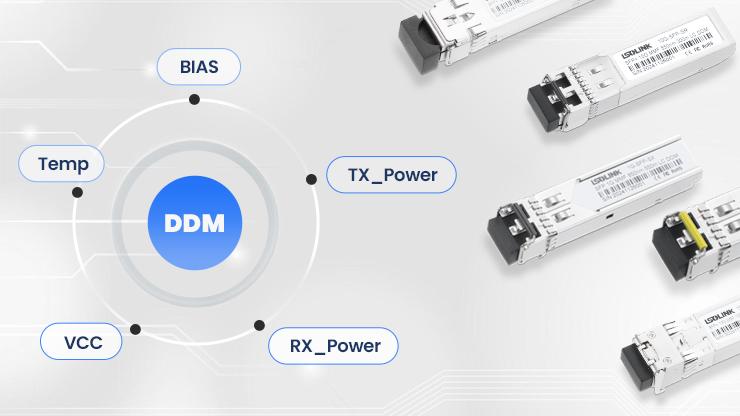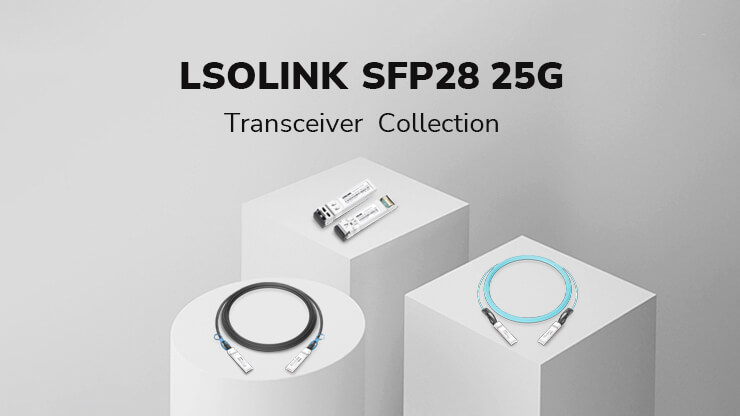Basic Introduction to SFP and SFP+
Small Form-factor Pluggable (SFP) is a compact, hot-swappable network interface module that quickly became the standard component for Ethernet, Fibre Channel, and other network connections after its introduction in 2001. Measuring only 1.5 inches in length and 0.5 inches in width, it supports data rates ranging from 155Mbps to 4.25Gbps, covering Fast Ethernet and Gigabit Ethernet scenarios. SFP modules use LC fiber connectors and support both multimode and single-mode fiber, making them suitable for personal home networks, small campus networks, as well as certain applications in metropolitan area networks (MANs).

Small Form-factor Pluggable Plus (SFP+) is an enhanced version of SFP, designed to meet the demands of 10Gbps high-speed data transmission. While maintaining the same physical dimensions as SFP, SFP+ increases the transmission rate to 10Gbps and reduces both power consumption and electromagnetic interference (EMI). Its electrical interface has been optimized with higher-speed signaling protocols, supporting multiple communication standards such as Ethernet and Fibre Channel. SFP+ is primarily used for high-speed interconnections between data center servers and switches, switch-to-switch links, as well as short-distance backbone transmission in metropolitan area networks (MANs).

SFP and SFP+ Compatibility Analysis
Inserting an SFP Module into an SFP+ Port
Regarding the compatibility between SFP modules and SFP+ ports, from a physical perspective, both share the same connector dimensions. This allows an SFP module to be properly inserted into an SFP+ port without any mechanical conflict. However, there are critical differences in electrical compatibility. SFP modules comply with IEEE 802.3 and SFF-8472 standards, supporting data rates up to 4.25Gbps, most commonly 1Gbps or 2.5Gbps. In contrast, SFP+ ports are designed according to IEEE 802.3ae and SFF-8431/8432 standards, supporting 10Gbps transmission while retaining backward compatibility.This means that when a 1G SFP module is inserted into an SFP+ port, the port can automatically negotiate down to 1 Gbps to match the module’s capabilities. In some cases, switches may require manual configuration of the port speed. Such scenarios are often seen when connecting legacy 1G devices to newer 10G switches, or when temporarily using a 10G port as a 1G port.
It is important to note that if an SFP+ port is manually forced into 10G mode within the switch configuration, inserting a 1G SFP module will result in the port failing to recognize the module or establish a link. Furthermore, certain specialized SFP modules, such as Fibre Channel (FC) or CWDM modules, may not be compatible with standard switches and require dedicated platforms, which should be confirmed with the switch vendor.
Inserting an SFP+ Module into an SFP Port
Unlike the previous case, inserting an SFP+ module into an SFP port presents significant limitations. The hardware and circuitry of an SFP port are generally designed to support data rates up to 4Gbps, making it incapable of directly handling 10Gbps high-speed signals. In addition, power delivery constraints may prevent the port from supplying sufficient and stable current required by a 10Gbps module, potentially leading to module malfunction. Even if the SFP+ module is physically inserted, the differences in signal processing often prevent the SFP port from properly recognizing or adapting to the module, thereby failing to establish a valid link.
Whether an SFP+ module can operate in an SFP port ultimately depends on whether the module itself supports adaptive down-speed functionality. Some vendors do offer such multi-rate modules, usually labeled as 1/10G or Multi-Rate. However, if the module does not support down-speeding, it cannot be used in an SFP port, as this may result in unexpected failures.
Impact of Vendor Differences on Compatibility
On the other hand, compatibility also varies among SFP and SFP+ devices produced by different vendors. As mentioned earlier, SFP+ ports can provide backward compatibility with SFP transceiver modules. However, when it comes to modules and switches from different manufacturers, specific compatibility codes may be required to achieve full functionality. For example, Cisco devices often have vendor codes preprogrammed in their firmware. When a third-party optical module is inserted, the device may refuse to activate the port or only allow limited functionality, such as disabling Digital Diagnostic Monitoring (DDM). In more severe cases, the port may even be forcibly shut down.
Exploring the Operation of 10G SFP+ Modules in 1G SFP Gigabit Switch Ports
From a physical perspective, 1G SFP gigabit switch ports are mechanically compatible with 10G SFP+ modules. However, at the electrical level, due to differences in protocols, data rates, and power requirements, 10G SFP+ optical modules cannot operate in SFP ports. In terms of feasibility, three critical factors must be considered: module selection requires choosing proper multi-rate models clearly labeled as “1/10G,” “Dual-Rate,” or “Multi-Rate”; the switch must support auto downshifting or allow manual adjustment of port speed while ensuring adequate power supply; finally, it is essential to verify the switch compatibility list to avoid firmware restrictions, making modules with the proper compatibility code a necessity. By correctly matching 10G SFP+ modules with SFP ports, limited interoperability can be achieved.
That said, from a hardware architecture standpoint, there exists a fundamental gap between 1G SFP gigabit ports and 10G SFP+ modules. The physical layer circuitry, signal processing chips, and protocol stack of a 1G SFP port are all designed around 1Gbps operation. Its signal bandwidth, clock frequency, and data processing capacity are strictly aligned with gigabit speeds. Since a 10G SFP+ module transmits data at ten times that rate, the 1G port’s hardware is incapable of interpreting the high-speed signals. Even if inserted, the port cannot recognize the module, and the link will remain down.
In theory, enabling 10G SFP+ operation on a 1G SFP port would require deep hardware modifications. This would involve replacing the physical layer chips with higher-speed components, redesigning the signal processing circuits, and upgrading the protocol stack. However, the cost and complexity of such modifications far exceed that of simply replacing the switch, making this approach practically infeasible. Some users have attempted to resolve this issue by introducing intermediate protocol conversion devices, such as rate converters that downshift 10G SFP+ signals to 1Gbps before feeding them into the port. Nonetheless, these solutions introduce additional deployment costs, potential latency, signal attenuation, and even packet loss, while also requiring strict compatibility across the module, converter, and port. The real-world effectiveness is therefore highly uncertain.
From a practical operations standpoint, it is not recommended to use 10G SFP+ modules in 1G SFP gigabit switch ports. If the network requires 10Gbps performance, it is advisable to adopt switches that natively support 10G SFP+ ports to ensure both performance and stability.
Conclusion
In practical network deployment and operations, the compatibility and rate adaptation between SFP and SFP+ must be carefully considered. Although SFP and SFP+ share the same physical form factor, they differ significantly in terms of speed, signal processing, and protocol support. SFP modules can be properly inserted into SFP+ ports, and since SFP+ ports typically support backward compatibility, SFP modules are able to function normally, providing convenience for network upgrades during transition phases.
However, most SFP+ modules cannot operate directly in SFP ports, as the hardware and protocol mechanisms of SFP ports are not designed to handle 10Gbps high-speed signal transmission. A 10G SFP+ module can only achieve downshifted operation in a 1G SFP gigabit switch port under three critical conditions: first, the module itself must natively support multi-rate adaptation; second, the switch port must be configured for auto-negotiation or forced 1G mode; and third, vendor-specific MCL codes must be used to bypass firmware restrictions. This compatibility essentially relies on the SFP+ module’s active downshifting capability to adapt to lower-speed ports, rather than any protocol upgrade on the port side. Its value lies in enabling smoother network upgrades, though it must be acknowledged that performance will remain capped at 1G after downshifting.
Frequently Asked Questions(FAQ)
Q:Will performance be affected when an SFP module is inserted into an SFP+ port?
A:Generally, when an SFP module is inserted into an SFP+ port, as long as the port supports backward compatibility, the SFP module will work normally and performance will not be negatively affected. The SFP+ port will automatically identify the rate and protocol of the SFP module and operate according to the specifications of the SFP module.
Q:Can I insert a 1G SFP module into a 10G SFP+ port and force it to run at 10G speed?
A:No. The physical circuit of the 1G module only supports 1.25Gbps signal. Forcing the SFP+ port to 10G mode will result in: port error, link failure, and even damage to the module in extreme cases. The SFP+ port must be set to auto to automatically reduce the speed to match.
Q:Will future higher-speed modules, such as SFP28 25G, also support speed reduction to 1G?
A:Not necessarily; please refer to the datasheet for details. The SFP28 is designed for dual-mode 10/25G, with only a few specialized models supporting 1G. The technological trend is for high-speed ports to be backward compatible with adjacent generation rates, such as 25G with 10G, rather than cross-generational compatibility with 1G.








